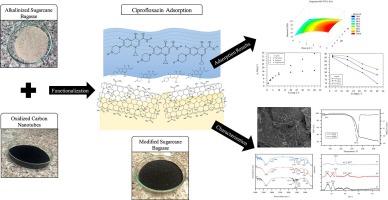用碳纳米管修饰的甘蔗渣对环丙沙星的吸附:参数和吸附机理的影响
Q1 Environmental Science
Environmental Nanotechnology, Monitoring and Management
Pub Date : 2024-10-16
DOI:10.1016/j.enmm.2024.101014
引用次数: 0
摘要
水体中出现越来越多的新污染物,如环丙沙星(CIP),凸显了人们对修复过程研究的兴趣。在这种情况下,吸附成为一种广泛使用的方法,既可以使用经济上可行的生物废料,也可以使用高效的特殊材料作为吸附剂。本研究的主要目的是用甘蔗渣(SB)和碳纳米管制备一种复合材料,研究其作为吸附剂去除 CIP 的适用性。该复合材料是通过超声波分散碱化甘蔗渣纤维和氧化碳纳米管制备的。通过一系列参数变化的批量实验测试了对 CIP 的吸收。利用扫描电镜、傅立叶变换红外光谱和 XRD 分析对其表面特性进行了表征。复合材料的 pHPZC = 6.46,活性酸位点比例为 61.67%,酚类基团占主导地位。与 SB 相比,氧化碳纳米管的加入使吸附能力提高了 20%。研究表明,在 pH 值接近 pHPZC 时,微酸性区域的吸附能力增强。事实上,有利于吸附的机制是 π-π 相互作用和低 CIP 溶解度。过程动力学遵循伪二阶模型和韦伯与莫里斯模型。最后,实验数据似乎与 Langmuir 模型相吻合,在 30 °C 时的最大吸附容量(qm)为 16.835 mg-g-1,但不排除 Freundlich 机制,因为两者的回归系数 R2 相似。本文章由计算机程序翻译,如有差异,请以英文原文为准。

Adsorption of ciprofloxacin on sugarcane bagasse modified with carbon nanotubes: Influence of parameters and sorption mechanism
The increasing occurrence of emergent pollutants in water bodies, such as ciprofloxacin (CIP), underscores the interest in the study of remediation processes. In this context, adsorption emerges as a widely utilized method, employing both economically viable biowaste and highly efficient specialized materials as adsorbents. The main objective of this research was to prepare a composite from sugarcane bagasse (SB) and carbon nanotubes to study its applicability as an adsorbent in the removal of CIP. The composite was prepared by ultrasonic dispersion of alkalinized sugarcane bagasse fibers and oxidized carbon nanotubes. The uptake of CIP was tested by a series of batch experiments with parameter variations. Surface properties were characterized by using SEM, FTIR, and XRD analysis. The composite had a pHPZC = 6.46 with a proportion of active acid sites of 61.67 % and a phenolic groups predominance. The addition of oxidized carbon nanotubes increased the sorption capacity up to 20 % compared with SB. The study revealed enhanced sorption in the slightly acidic zone at pH values close to pHPZC. Indeed, mechanisms favorable to sorption were π-π interaction and low CIP solubility. Process kinetics followed pseudo the second order and Weber and Morris models. Finally, experimental data seemed to fit the Langmuir model with a maximum adsorption capacity (qm) of 16.835 mg·g−1 at 30 °C, without disregarding the Freundlich mechanism since the regression factor R2 is similar for both.
求助全文
通过发布文献求助,成功后即可免费获取论文全文。
去求助
来源期刊

Environmental Nanotechnology, Monitoring and Management
Environmental Science-Water Science and Technology
CiteScore
13.00
自引率
0.00%
发文量
132
审稿时长
48 days
期刊介绍:
Environmental Nanotechnology, Monitoring and Management is a journal devoted to the publication of peer reviewed original research on environmental nanotechnologies, monitoring studies and management for water, soil , waste and human health samples. Critical review articles, short communications and scientific policy briefs are also welcome. The journal will include all environmental matrices except air. Nanomaterials were suggested as efficient cost-effective and environmental friendly alternative to existing treatment materials, from the standpoints of both resource conservation and environmental remediation. The journal aims to receive papers in the field of nanotechnology covering; Developments of new nanosorbents for: •Groundwater, drinking water and wastewater treatment •Remediation of contaminated sites •Assessment of novel nanotechnologies including sustainability and life cycle implications Monitoring and Management papers should cover the fields of: •Novel analytical methods applied to environmental and health samples •Fate and transport of pollutants in the environment •Case studies covering environmental monitoring and public health •Water and soil prevention and legislation •Industrial and hazardous waste- legislation, characterisation, management practices, minimization, treatment and disposal •Environmental management and remediation
 求助内容:
求助内容: 应助结果提醒方式:
应助结果提醒方式:


